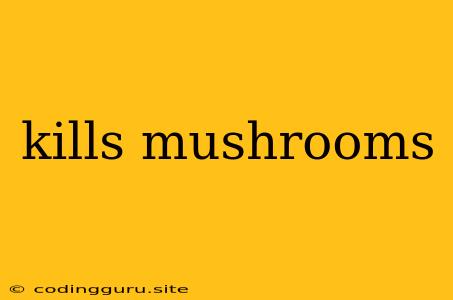Killing Mushrooms: A Guide to Eradicating Unwanted Fungi
Mushrooms, while a culinary delight for many, can quickly become an unwelcome guest in your garden or lawn. Their sudden appearance can be a cause for concern, especially if you have children or pets who might be tempted to ingest them. Understanding the nature of these fungal invaders and employing the right techniques are crucial for effectively killing mushrooms and preventing their return.
Why are Mushrooms Growing in My Yard?
Mushrooms are the fruiting bodies of a much larger fungal network called mycelium, which resides beneath the surface of the soil. They thrive in moist, humid environments and feed on decaying organic matter like fallen leaves, grass clippings, and tree roots. This explains why mushrooms often appear after heavy rainfall or in areas with poor drainage.
Are Mushrooms Harmful?
While many mushrooms are harmless, some can be poisonous and pose a serious threat to human and animal health. Therefore, it's crucial to avoid ingesting any mushroom found in your yard without positive identification by a qualified expert. If you have children or pets, it's best to err on the side of caution and remove any mushrooms you encounter.
Methods to Kill Mushrooms
1. Remove the Fruiting Bodies:
The most immediate solution is to physically remove the mushrooms. This doesn't eradicate the mycelium, but it helps prevent spores from spreading and producing new mushrooms.
- Tip: Use a shovel or garden trowel to carefully dig out the mushrooms and dispose of them in the trash. Do not compost them as this will only spread the fungal spores.
2. Improve Drainage:
Mushrooms thrive in moist conditions. Improve drainage in your yard by:
- Aerating the soil: This allows water to penetrate the soil more easily.
- Adding mulch: Organic mulch like wood chips or shredded bark can help regulate soil moisture.
- Installing drainage systems: If your yard has poor drainage, consider installing a drainage system to redirect excess water.
3. Remove Food Sources:
Mushrooms feed on decaying organic matter. To limit their growth, remove potential food sources by:
- Cleaning up fallen leaves and debris: Rake up leaves regularly to prevent their decomposition and provide a less favorable environment for mushrooms.
- Composting properly: Don't compost mushroom-infested material as this will spread the spores.
- Reducing excessive mulch: Too much mulch can create a damp, decomposing environment that attracts mushrooms.
4. Use Fungicides:
While not always necessary, fungicides can effectively target and destroy fungal mycelium. However, consider the following:
- Safety: Fungicides can be harmful to pets, children, and beneficial organisms in the soil.
- Efficacy: Not all fungicides are effective against all types of mushrooms. Consult with a lawn care specialist to determine the best product for your situation.
- Environmental Impact: Choose environmentally-friendly fungicides whenever possible.
5. Sunlight and Airflow:
- Sunlight: Mushrooms generally prefer shady environments. Improve airflow and increase sunlight exposure by trimming overhanging branches or thinning out dense vegetation.
- Airflow: Encourage airflow by removing obstacles like dense shrubs and tall grasses.
6. Prevention is Key:
- Regularly inspect your yard: Early detection is key. Monitor your lawn for signs of mushroom growth.
- Proper soil testing: Understand the pH and nutrient content of your soil. Adjust these factors to create an environment less favorable to mushrooms.
7. Patience and Persistence:
Eliminating mushrooms requires patience and persistence. The mycelium is a resilient network that can take time to eradicate. Continue to monitor your yard and apply the methods outlined above to ensure the problem is effectively addressed.
Conclusion
Mushrooms in your yard can be an unsightly and potentially hazardous nuisance. By understanding the conditions that favor their growth, removing food sources, and implementing proper drainage techniques, you can significantly reduce their presence. Remember to always prioritize safety and use effective methods to control these unwelcome fungi. With a bit of effort and a consistent approach, you can create a mushroom-free environment and enjoy your yard without worry.
